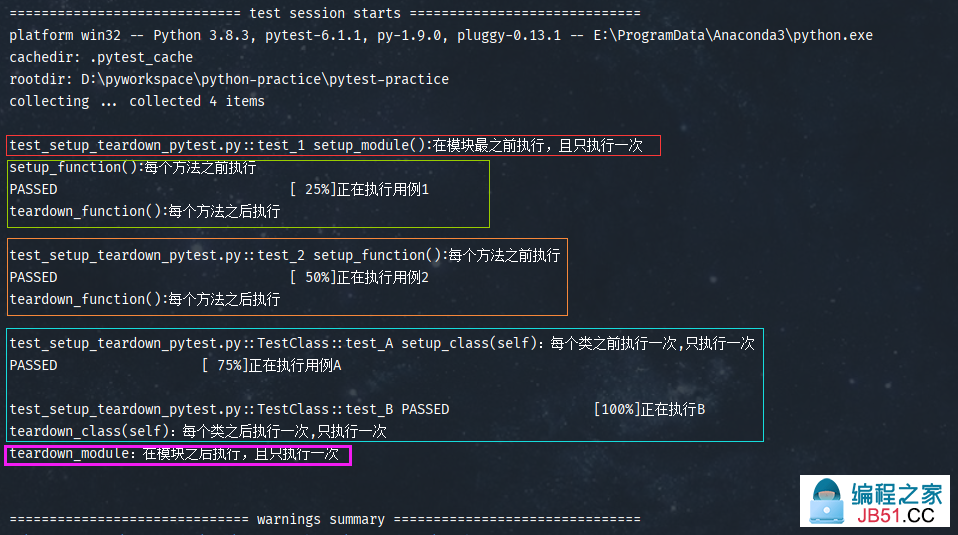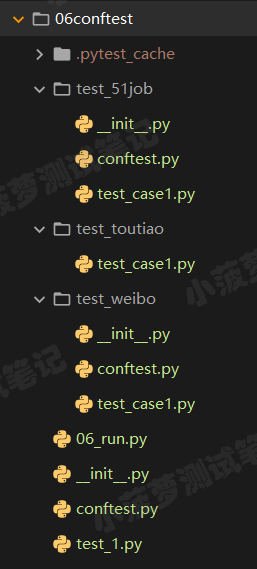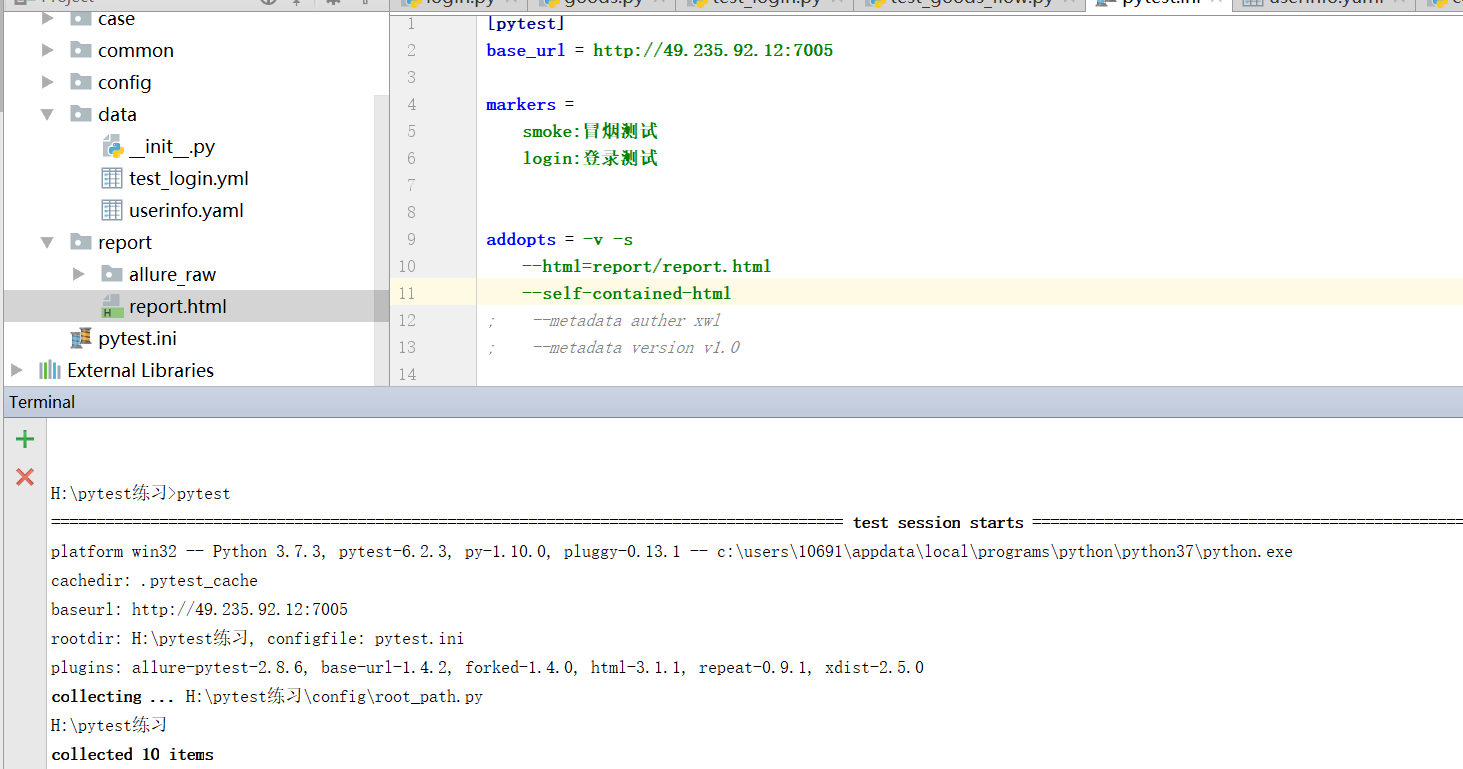一、前言
从文章标题可以看出,就是初始化和释放的操作,根据我的java习惯来学习pytest,个人感觉没差太多,理解上也不是很难。
哦,对了,差点跑题了,这个框架是基于Python语言的,在学习的时候难免总会用java的类比思想来学习,下面言归正传哈。
我们还从 unittest与pytest来对比学习吧
二、unittest用法
unittest有两个前置方法,两个后置方法,分别是:
- setup()
- setupClass()
- teardown()
- teardownClass()
个人始终觉得unittest和Junit像极了。
三、pytest用法
当然,Pytest也提供了类似setup、teardown的方法,分别是:
- 模块级别:setup_module、teardown_module
- 函数级别:setup_function、teardown_function,不在类中的方法
- 类级别:setup_class、teardown_class
- 方法级别:setup_method、teardown_method
- 方法细化级别:setup、teardown
我总感觉学习pytest像是在学习testng一样,难道是我的错觉吗,啊啊啊啊,不能吧。
四、unittest示例
unittest的setupClass和teardownClass,需要配合@classmethod装饰器一起使用,也就是我们java说的注解呀,这块是翻译给java学Python的同学的,可忽略哈。
示例代码如下:
# -*- coding: utf-8 -*-
# @Time : 2020/10/21 20:09
# @Author : longrong.lang
# @FileName: test_setup_teardown_unittest.py
# @Software: PyCharm
# @Cnblogs :https://www.cnblogs.com/longronglang
'''
unittest代码示例
'''
import unittest
class TestUnitTest(unittest.TestCase):
@classmethod
def setUpClass(cls):
print("所有用例执行前执行")
def setUp(self):
print("每个用例开始前执行")
def tearDown(self):
print("每个用例结束后执行")
@classmethod
def tearDownClass(cls):
print("所有用例执行后执行")
def testA(self):
'''用例A'''
print("用例A执行了")
self.assertEquals(1,1)
def testB(self):
'''用例B'''
print("用例B执行了")
self.assertTrue(True)
if __name__ == "__main__":
unittest.main()
执行结果

可以看出执行顺序为:
setUpClass
setUp
testA
tearDown
setUp
testB
tearDown
tearDownClass
用例之间按用例名称ASCII码的顺序加载,数字与字母顺序为0~9,A~Z,a~z,所以testA会在testB之前运行。
五、pytest示例
函数级的setup_function、teardown_function只对函数用例生效,而且不在类中使用
依旧还是把类和函数都有的情况放在一起,示例代码如下:
# -*- coding: utf-8 -*-
# @Time : 2020/10/21 20:27
# @Author : longrong.lang
# @FileName: test_setup_teardown_pytest.py
# @Software: PyCharm
# @Cnblogs :https://www.cnblogs.com/longronglang
'''
pyetest示例
'''
import pytest
def setup_module():
print("setup_module():在模块最之前执行,且只执行一次")
def teardown_module():
print("teardown_module:在模块之后执行,且只执行一次")
def setup_function():
print("setup_function():每个方法之前执行")
def teardown_function():
print("teardown_function():每个方法之后执行")
def test_1():
print("正在执行用例1")
x = "this"
assert 'h' in x
def test_2():
print("正在执行用例2")
assert 1 == 1
class TestClass(object):
def setup_class(self):
print("setup_class(self):每个类之前执行一次,只执行一次")
def teardown_class(self):
print("teardown_class(self):每个类之后执行一次,只执行一次")
def test_A(self):
print("正在执行用例A")
x = "this"
assert 'h' in x
def test_B(self):
print("正在执行B")
assert 1 == 1
if __name__ == "__main__":
pytest.main(["-q","test_setup_teardown_pytest.py"])
执行结果

可以看出来,互不影响,执行顺序为:
setup_module()
setup_function()
test_1
teardown_function()
setup_function()
test_2
teardown_function()
setup_class(self)
test_A
test_B
teardown_class(self)
teardown_module
main方法中的-q,为pytest打印测试用例的执行结果级别。
如不清楚,请移步到《Pytest学习(一)- 入门及基础》。

 什么是conftest.py可以理解成一个专门存放fixture的配置文件...
什么是conftest.py可以理解成一个专门存放fixture的配置文件... 前言pytest默认执行用例是根据项目下的文件名称按ascii码去收...
前言pytest默认执行用例是根据项目下的文件名称按ascii码去收... 当我们对测试用例进行参数化时,使用@pytest.mark.parametri...
当我们对测试用例进行参数化时,使用@pytest.mark.parametri... 前言:什么是元数据?元数据是关于数据的描述,存储着关于数...
前言:什么是元数据?元数据是关于数据的描述,存储着关于数...